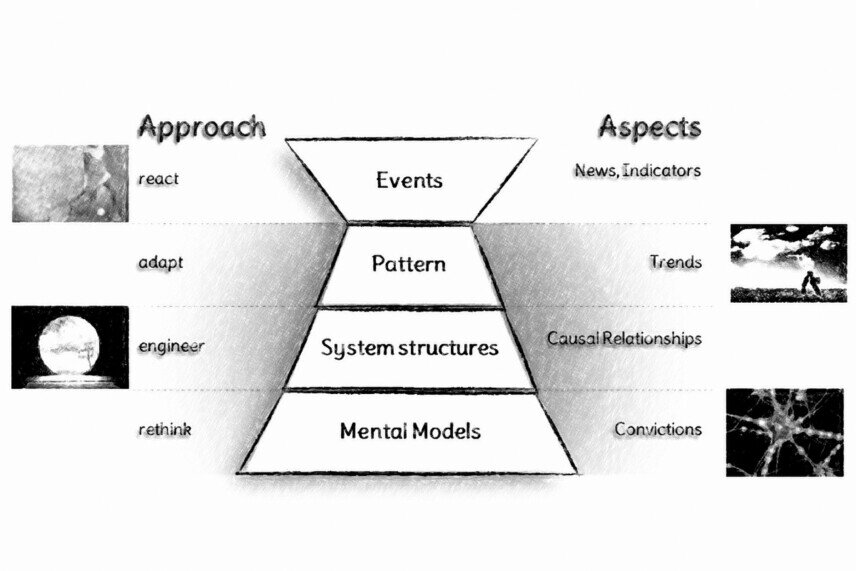System levels
System Levels is a model for discussion on systems. The iceberg, based on Peter Senge, serves as a metaphor. Above the water surface, the apparent incidents are found, i.e., visible events to everybody. Underwater are lying levels of views that, on the one hand, represent reaction approaches and, on the other hand, contain aspects that enable solutions. Each system level needs a particular response time - the more profound, the longer. The sustainability of the effect increases with the depth of the level, e.g., after the development of convictions, they function for a long time and can only be changed again with tremendous efforts. The conscious selection of the system level simplifies the solution and accelerates realization by concentrating on the specific level.

The individual system levels become more complex, the deeper they are. The increasing vagueness results in bigger efforts for the description and task realization.
- Event
Events are news and indicators that occur and are documented. The objective description consists of visible facts, e.g., description (which), time (when, how often, which intervals), a cause (trigger), effect (result). Spontaneous solutions can be defined here if they are not present yet. Crisis plans describe immediate reactions to anticipated crises. On this level, fast responses are required without understanding the system's deeper mechanisms (Black Box).
- Pattern
Patterns are trends that develop within a defined time. Usually, they illustrate the ideal distribution and can be assigned to models (Kondratiev-wave, Hype-cycle) or systems archetypes (e.g., escalation, growth). These patterns are the basis for experience-based adjustments. Due to the behavior-over-time adaption steps are available, which can affect the trend as desired. On this level, the determination of patterns needs a certain time, e.g., events have to be collected and evaluated to determine behavior-over-time in the first step. The system is not yet understood, but an experience-based reaction is possible.
- System structure
System structures describe causes and effects. These can be analyzed with the systems archetypes' help, and potential solution approaches may be derived. If there are several causal loops, it is called the system model. The development of a system model and its analysis need much time because the participants have to model, analyze, and discuss the events to derive measures eventually. On this level, the system is considered for the first time, i.e., a common understanding is reached that creates starting points that enable a fundamental improvement of the system behavior.
- Mental model
Mental models are all convictions that affect the participants and their actions, i.e., values, strategies (vision, mission, critical success factors, strength weaknesses/ opportunity risks, strategic direction, strategic goals), assumptions, expectations, and personal meta-programs. As a description of the reality, the system model gets from the mental models the underlying explanation of the situation. The study of mental models needs most of the time since it concerns each participant's fundamental attitudes. To determine and formulate these hard to seize aspects and finally realize the approaches for rethinking goes far beyond the duration of a single project. It usually requires an overall organizational development.
The highest level can be derived easily from existing publications. The further you go deeper, the more difficult it becomes to recognize facts. However, the achievable effects have a more lasting impact.

